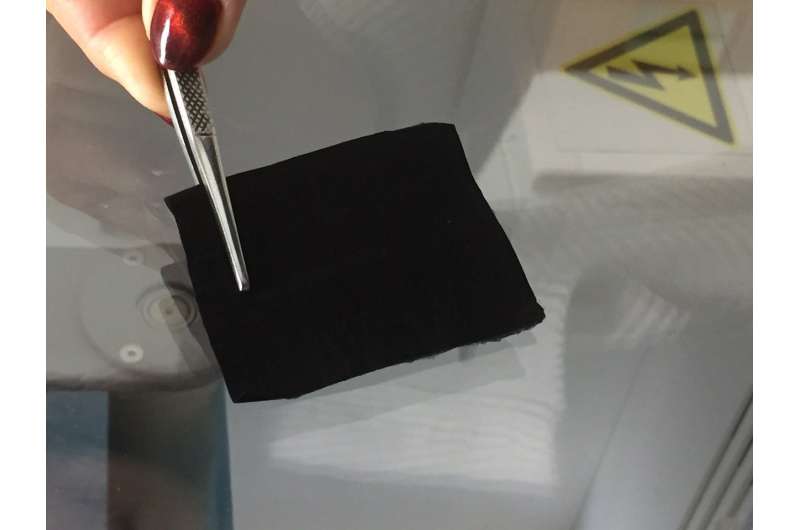Developing environmentally friendly materials

A new research article introduces a nanofiber material produced by the electrospinning device at the Laboratory of Polymers and Textile Technology in Tallinn University of Technology, and a range of applications. The article, titled "A method for producing conductive graphene biopolymer nanofibrous fabrics by exploitation of an ionic liquid dispersant in electrospinning," was published in Carbon.
It is not possible to produce fibers with a diameter smaller than a micrometer by using conventional fiber spinning methods. However, via electrospinning technology, researchers can fabricate nanofibers by applying high voltage to a polymer solution. In recent years, there has been a surge of interest in electrospinning. One of the co-authors of the research article, Professor Andres Krumme, says, "The electrospun carbon nanomaterial can also be called smart fabric. The nanofibers forming the material are 100 times thinner in diameter than hair, and are extremely strong, tough, flexible, and due to carbon content, also conductive. The material allows efficient energy storage owing to its high surface area."
The specific properties of nanofibers render it a promising material for future applications:
- In environmental protection, the non-woven fabric can be used to clean contaminated air or water from fine particulate matter and heavy metals. In agriculture, it can be used as a shade cloth for plants to keep away insect pests
- In medicine, the nanofabric can be used to grow cells and produce antibacterial plasters and bandages. Nanofibers can be used to create cell culture media (stem cells are seeded on a biopolymer mat) and the grown stem cells can then be transplanted to damaged human skin.
- In the clothing industry, nanofibrous materials can be used to produce special protective clothing that stores energy for charging mobile devices. Nanofibrous electrodes with enhanced mechanical properties can be used as components of smart clothing to monitor and affect the health condition of the wearer. Garment sensors provide information about the wearer's needs as well as potential emergency situations (rescuers, fishermen, etc.).
"Cellulose used as the original raw material of smart fabric is very acceptable for human body due to its properties, i.e. the raw material used in polymer fabric is bio-based and supports the natural carbon cycle," Andres Krumme says.
More information: Kashif Javed et al, A method for producing conductive graphene biopolymer nanofibrous fabrics by exploitation of an ionic liquid dispersant in electrospinning, Carbon (2018). DOI: 10.1016/j.carbon.2018.08.034
Journal information: Carbon
Provided by Estonian Research Council



















